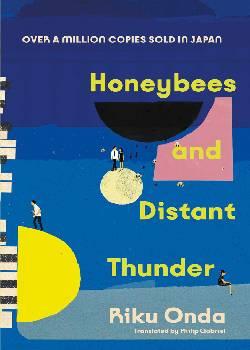Honeybees and Distant Thunder

By Onda Riku
Translated by Philip Gabriel
Doubleday (2023)
ISBN-13: 978-0857527950
Review by George Mullins
Over the past month I have had the pleasure of reading this wonderful book by Onda Riku. Honeybees and Distant Thunder is a book about sounds, nature, music and inspiration. The story is set around an international piano competition and follows the journey of its competitors.
The story focuses on the fictional Sixth Yoshigae International Piano Competition, being held in Japan. We follow the prestigious competition and its group of international competitors from the entry auditions to the opening of the contest and all the way until it’s completion. The book’s chapters are segregated into corresponding parts of the competition, following this order: entry, round one, round two, round three and the finals.
What I found most intriguing about Honeybees and Distant Thunder is that rather than following the story from the point of view of one character in particular, the competition actually enfolds from the perspective of many different actors. We start by learning about some of the judges, and then the personalities of the competitors. We even observe the competition from the eyes of more minor players such as the piano turner, a reporter and a competitor’s wife. Each performer has their own style and relationship with music. There are child geniuses, and one competitive character sees the competition as akin to a sporting event. Another character describes himself as a family man playing ‘ordinary man music’. Learning about the different performers, their history and relationship to music is a particular pleasure of the story.
This shifting perspective gives us a comprehensive overview of this fictional international piano competition, providing a deeper sense of reality. This multiple-view perspective also allowed me to pick my own favourite competitor and follow their journey. Without wanting to spoil anything, I will say that the character I was routing does not win the competition in the end!
Although there are many different characters and performers, an important story flowing alongside the competition is that of pianist named Jin Kazama, or 風間塵 in Japanese. The author tells us that, rather ironically, the “Jin” in his name uses the same kanji as “dust” or “rubbish”! Jin is a young and unconventional performer, whose idiosyncratic style of playing both impresses and appals the judges in equal measure. His laid-back attitude and genius act as an interesting catalyst for book.
Lovers of classical music will surely enjoy this book. Characters discuss famous classical piano ballads and concertos and the author wonderfully describes the sounds of the pianists. For instance, she describes one character’s playing as ‘free and easy, so generous, yet with a haunting insight’. Readers with a good knowledge of classical music will take pleasure in imagining melodies as they read about the different characters’ styles of playing.
On the other hand, people like me with only a layman’s grasp of music can also easily enjoy this book too. The stress and tension of the competition is palpable and the characters’ (and author’s) love of music shines through each page, making it a very inspiring read. I found myself sitting on the edge of my seat as I got more and more invested in certain characters and wanted them to succeed in the competition. The countless references and descriptions of famous piano pieces also act as a good springboard for learning more about classic music. For example, thanks to this book I have discovered a wonderful piece called Je te veux by a French composer Erik Satie.
The author of Honeybees and Distant Thunder, Onda Riku, is a celebrated writer in Japan. When this book was first published in Japanese in 2017, it became a bestseller, selling over a million copies. It also became the first novel to win both the Naoki Prize and the Japan Bookseller’s Award. In 2019, the book was even turned into a successful Japanese film.
The translator, Philip Gabriel, does a great job on this English translation. He gives us some useful explanations regarding Japanese language and culture, helping us understand nuances that can often get lost in translation. His description of a character’s name, Aya Eiden, whose last name Eiden, 栄伝, roughly means ‘to convey glory’ in English, springs to mind. I feel that this kind of information allows us to better grasp the story and are helpful to anyone interested in Japan.
I would highly recommend Honeybees and Distant Thunder not only to those interested in classical music, but also to anyone who has a vague passion for music, and wants to learn more about Japan.

